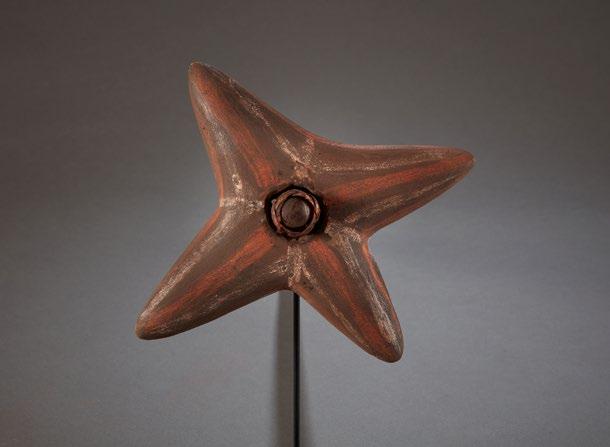
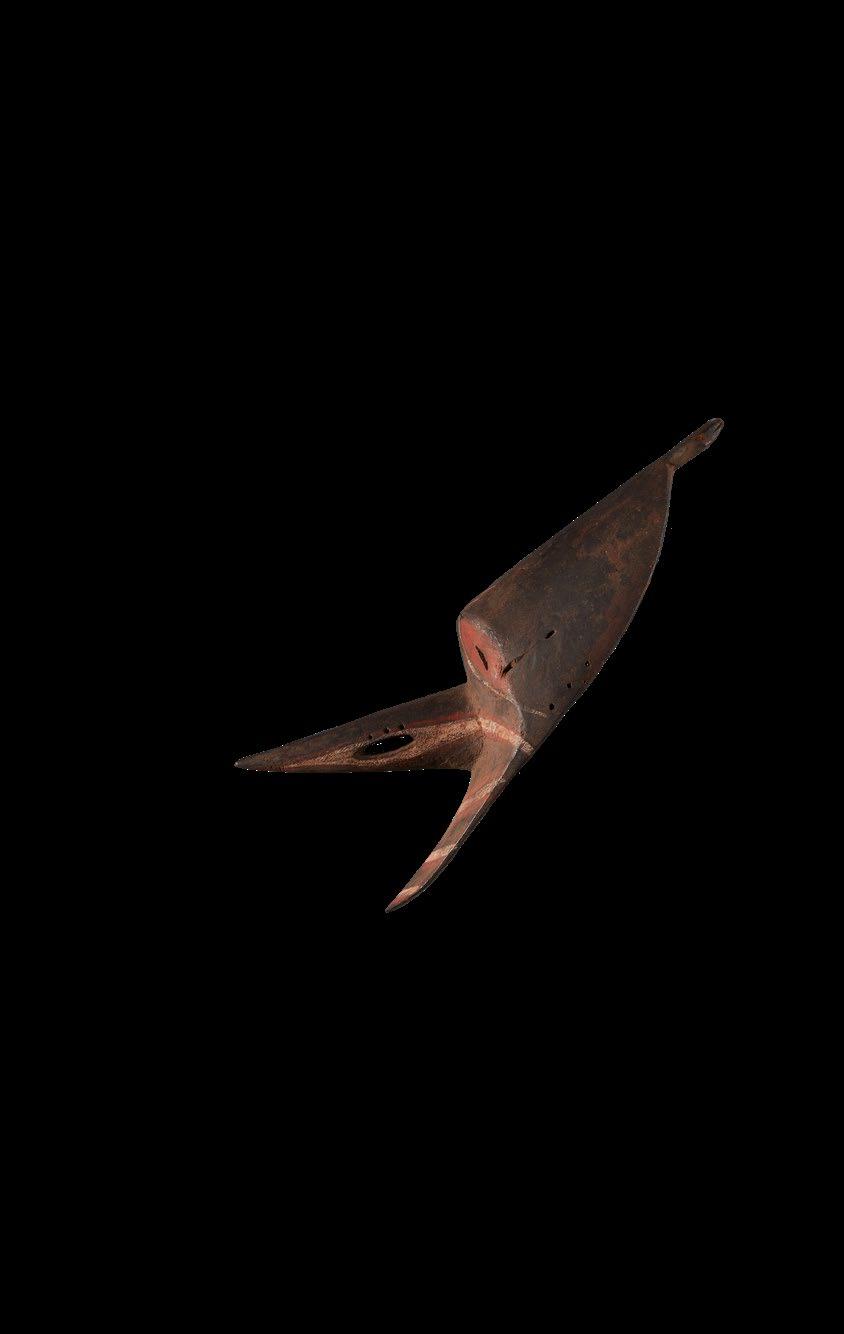



email: info@chrisboylan.com.au
www.chrisboylan.com.au
TEL: +61 405 093 577
I live in Sydney, Australia and do not work from a gallery due to my many travels, but instead from home office and my Sydney warehouse. My yearly schedule (pandemic years apart) includes several trips to Papua New Guinea and various Pacific regions, with exhibitions within Australia and overseas. An avid field collector, I still greatly enjoy these Pacific odysseys, and always come across some fine and interesting art works. Having said that, old collections and small auctions within Australia can also be a rich resource for artworks.
San Francisco Tribal Show is online in 2023 and by catalogue once again this year. For many years it has been the most important Tribal Art Show in the Americas; and I look forward to being back in person for 2024.
All prices $ US.

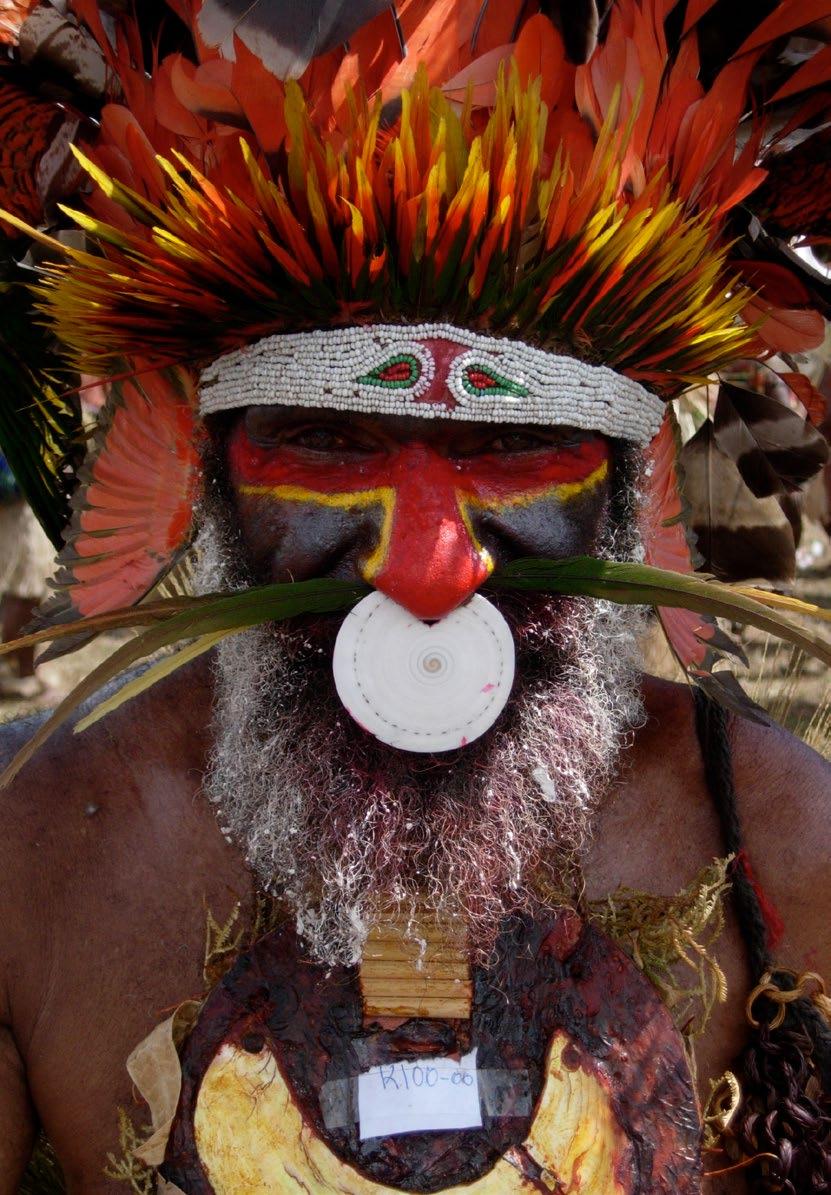
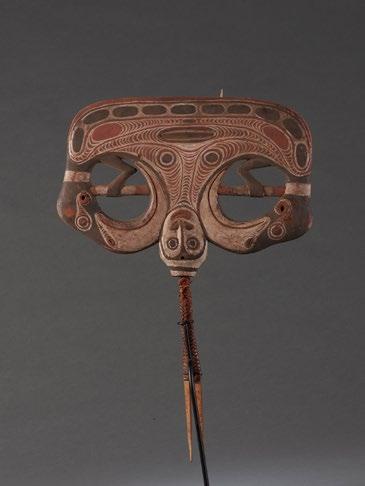
This dance headdress forms one of the crowning ornaments used in conjunction with the avan, a conical woven costume that completely covers the male dancer’s body. In the mai(what is this) ceremony a large shell-encrusted mask is fixed at the front of the avan. This headdress is at the apex, profusely embellished with feathers. As the dancer moves, the cane connection allows the headdress to bounce backwards and forwards in energetic motion, highlighting the dancer’s movements and the beating drums.
The headdress is carved from a soft wood; considering its age it is in almost perfect condition, with the paintwork very well preserved. It is dominated by a single ancestor face on front and back, with two large water birds, totemic birds of the clan. The headdress was collected in Tambanum village in 1971-1972.
 64 x 44 x 3 cm $3,800
Iatmul dancer, in the Middle Sepik village of Kararau. A wooden headdress like Object 1. Would be at the pinnacle of such a dance costume, moving vigourously with the dancer.
Photo: Jorg Hauser; “Art of the Sepik River”, 1985
64 x 44 x 3 cm $3,800
Iatmul dancer, in the Middle Sepik village of Kararau. A wooden headdress like Object 1. Would be at the pinnacle of such a dance costume, moving vigourously with the dancer.
Photo: Jorg Hauser; “Art of the Sepik River”, 1985
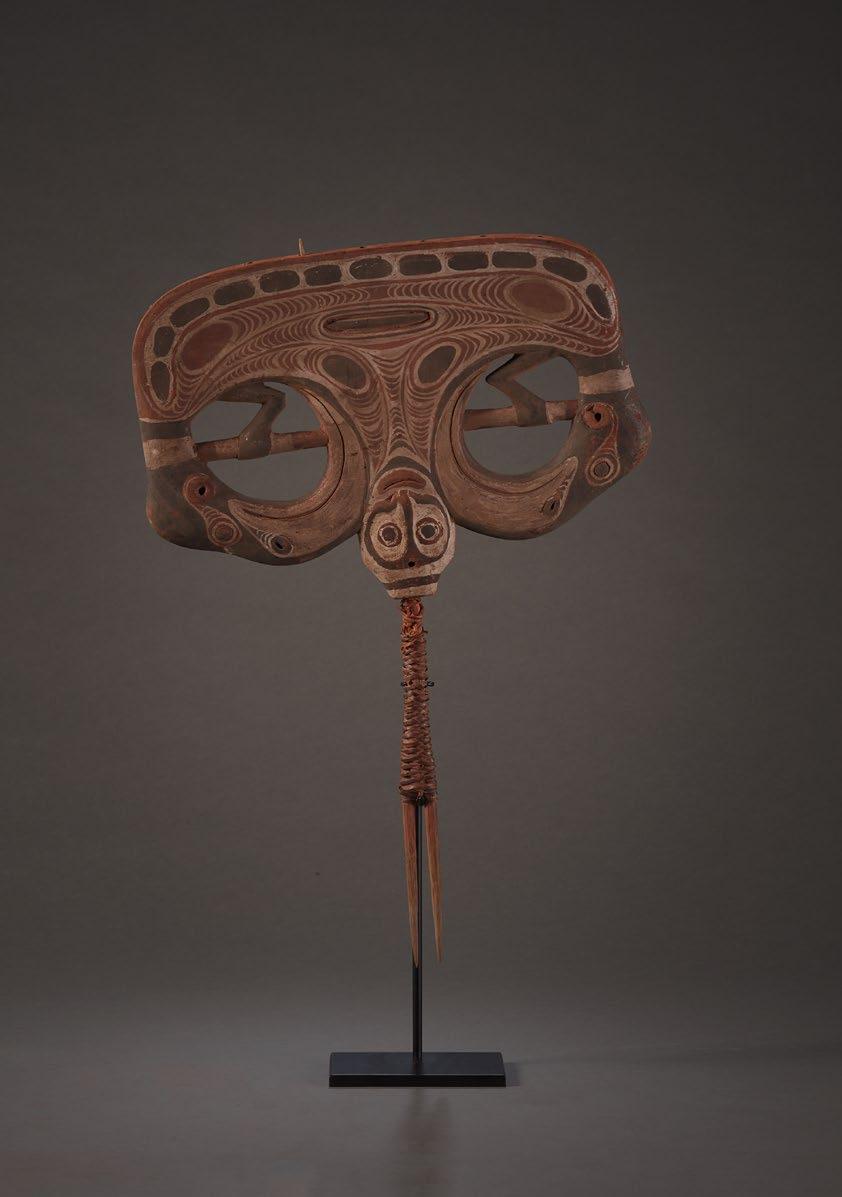
2. Dance Mask, Barak, Inland Turubu area, East Sepik, PNG 19th / early 20th Century. Wood, pigment.

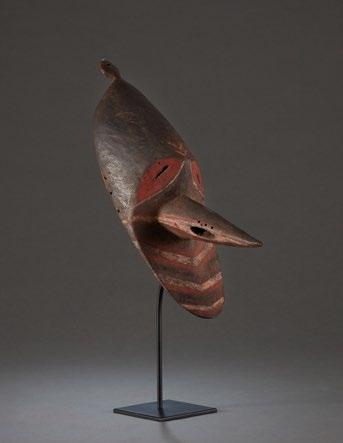
The form of the barak, with a high dominant brow, an elegant, curved side view, and sharp pointed nose, give these masks a strength and simplicity that masks from other regions rarely achieve. The mask is dark in colour, embellished with typical red and white pigments. These masks represent male mythical spirits and were generally stored away from the village in a small bush hut, that acted shrine-like. Such masks helped with hunting and garden fertility: importantly also they were danced in male initiation ceremonies. It is often referred to as a “mosquito mask”, but in fact represents a bird totem.
$9,500
 48 x 15 x 21 cm
48 x 15 x 21 cm


This is an old shield, from a remote Okapa region of the Eastern Highlands region, used over several generations of fighting. Shields among the Fore people, who live near the small patrol post of Okapa, are carved from two main woods: a softer wood, called verafa and a harder timber called ufozei. This shield is made of verafa, the most common. They are thicker and often engraved with fine chevron designs. The back of the shield has a small bag to hold extra arrows, and a rope to help support the top of the arrows.
The painted design on the shield, which pays no attention to the underlying engraved motifs, appears abstract. But informers among the Fore say it symbolises two different, but connected elements of the earth. The parallel lines depict garden trenches for growing yams and sweet potato: the Fore say, we paint gardens on our shields “because this is what we fight for”. The zig-zag lines towards the bottom depicts lightning; it is believed powerful Sky Spirits send the lightning, and these spirits must be respected and feared.
 144 x 42 cm
144 x 42 cm



Between the Huon Gulf region, around the southern tip of New Britain to Cape Gloucester and the Witu Islands, there is a coherent cultural region that for centuries has been part of trade networks. These trade networks saw also the movement and an active exchange of objects and ideas. This mask has many of the stylistic and materialistic attributes of the Tami Islands, but also some of those of the south coast of New Britain. It lacks the bold zig-zag black motifs of Tami and the Huon Gulf, with softer forms and more use of colour. These tapa masks were essentially used in rites of passage for initiation and also at dances celebrating the planting and harvesting of taro. This specific mask has many features of the Natatauvo mask of the Kilenge, but also Tami features that suggest it may have originated on the south coast of New Britain from the Arawe or Rauto regions.
Ex-collection Eric Coote, Mittagong, Australia.
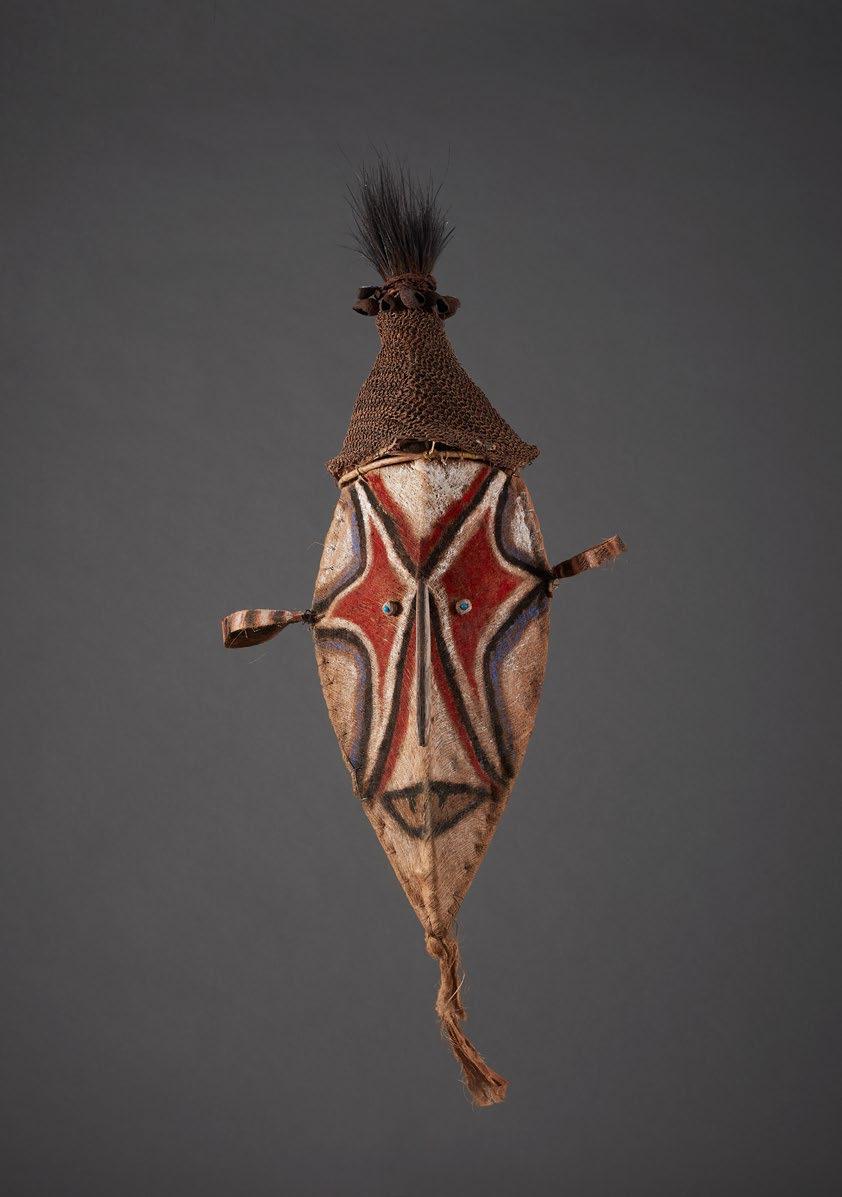
5. Flute Stopper, Chambri Lakes, Middle Sepik River, PNG Wood, fibre, pigment.

Ceremonial flutes in the Middle Sepik are the important sacred musical instruments of the region. They comprise a long bamboo shaft (up to 250cm) with a single mouth hole. One end is open, the other is filled with an elaborate flute stopper, a slender carved figurative form, often incorporating animal forms. Within the Middle Sepik, the flute players of Chambri Lake are considered among the best, as are their flute stoppers. Flutes are played only by men, in secret inside the Spirit House, in pairs. Two flute players will stand adjacent to each other, often touching feet, and the melodious tones, rising and falling, follow each other giving the most beautiful effects. They are considered the voices of the spirits and, together with the large slit gongs (garamuts) form the foundations of the incredible sacred music of the Middle Sepik. The Chambri Lake flute stoppers are among the most elegant, often being a slender male figure. This figure is superbly carved, with fine scarification detail, and a face painted half red and half white. Together the music and stopper represent the structure of the society, its duality. Accompanying songs refer to mythical times and mythical protagonists. Within the melodious music,the structure of the ancestor world of Sepik culture is brought to life during each of the accompanying important ceremonies. Ex-collection Eric Coote, Mittagong.
$3,500
74 x 7 x 7 cm Flutes being played ceremonially in the Sepik. Traditionally, only played inside the Men’s Spirit House.

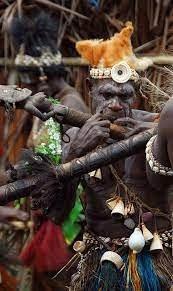

6. Old Figure, Mundugumor, Yuat River, Lower Sepik River, PNG Wood. Collected by Pierre Langois in an early 1970s Sepik expedition.
This old figure has a strong, warriorlike stance, with typical blockish form of Mundugumor sculpture, incorporating especially an intense visage; legs are apart, with hands on the thighs, evoking a sense of restrained movement. The penis has been carved in crocodile form, the most powerful of all creatures in the Sepik world, and one of the most important creation spirits. Such a figure would be kept on a platform in the Spirit House, and sought for intercession in troubled times, especially at times of warfare. It would have had a personal name, but this was never recorded. Ex-Australian private collection.


 57 x 21 x 18 cm $3,800
57 x 21 x 18 cm $3,800
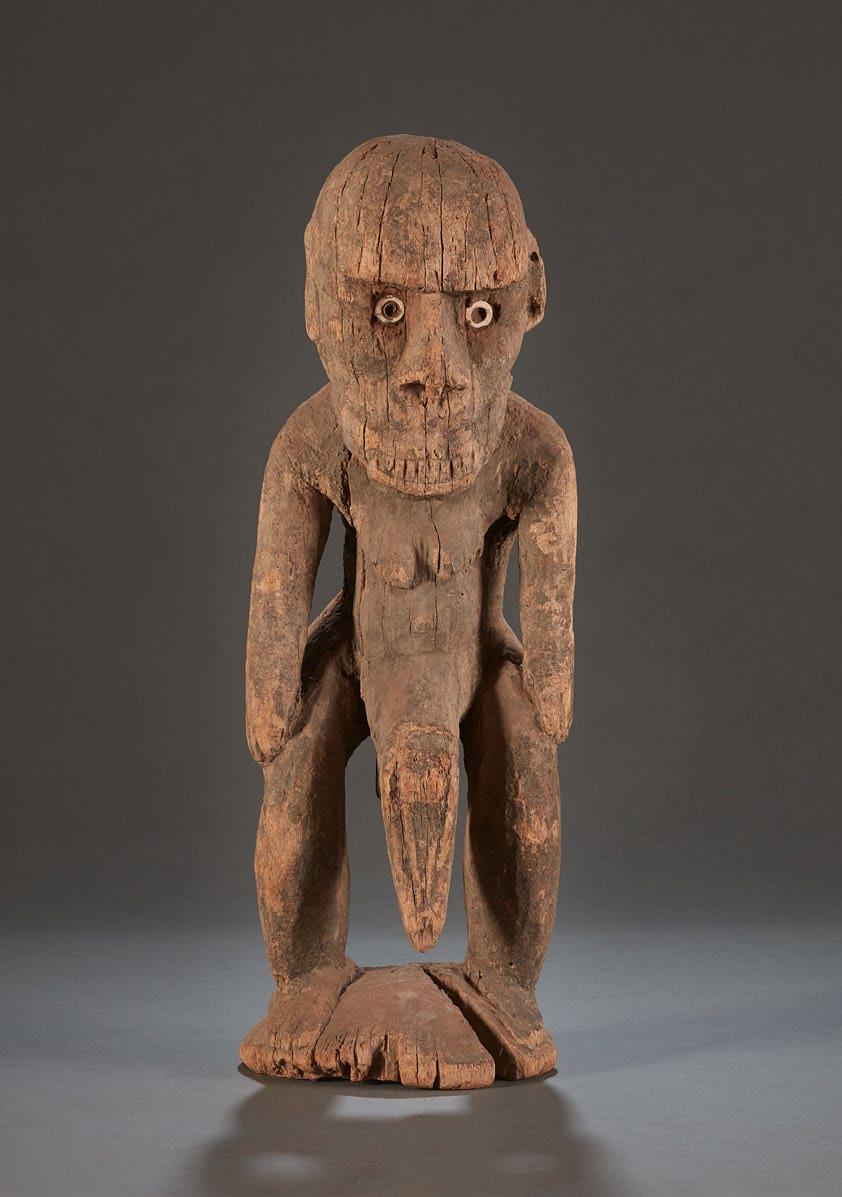
7. Two Aboriginal Bark Paintings, “Wandjina”, Kimberley Ranges, Western Australia Bark, pigment.
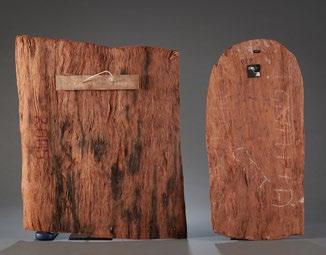
“Wandjina” is the Aboriginal spirit of water and monsoons, in the North West coastal regions of Western Australia. It is a dry area, that is deluged yearly by the monsoons, that bring life to the land. Images of the Wanjina are found in caves and rock shelters throughout this region. Certain families have the authority to protect and repaint these images as necessary.
a) Large painting depicting the upper torso of a Wandjina spirit. Typically the face is white, with emblazoned eyes, a simple nose, and no mouth. On the back is a number, “2065”, which would have been catalogued at one of the Aboriginal art centres in the 1980s-1990s. Artist: unknown.

b) A medium sized painting showing the Wandjina figure above the legs, and a striking snake figure curved around – no doubt the powerful Rainbow Serpent. This is a fine example, with the number “987”, added by the original collector, Pierre Mariceaux. Artist: Waigan Djanghara, 1970s
a) 65 x 56 cm
b) 69 x 33 cm a) $2,000 b) $3,000
Wandjina rock art, Kimberely Ranges, W.A.

a) Old Underarm Shield, Mendi Valley, Southern Highlands, PNG
This is a finely carved shield, made from warr wood, and engraved with an abstract figure, that is generally understood to be an ancestor. The figure is most likely an ancestor who died in battle, and asked to give protection in war to the warrior and, importantly, revenge against the enemy. Collected in 1972 by Ed Boylan on his first trip to the New Guinea Highlands.
b) Old Underarm Shield, Wanuma, Adelbert Ranges, Madang Highlands.
The wood is very hard, and arrows that hit the shield would break or bounce off. A cane shoulder strap has its remnants only remaining, and gives an indication of how it was carried. The painted surface is essentially abstract, but close inspection shows a face emerging. Collected c. 2005 by Michael Hamson on one of his few expeditions in this remote Highland region.
a) 65 x 56 cm
b) 69 x 33 cm
a) $3,800
b) $3,500

 Underarm shield, elyabor, in warfare preparations, Mendi Valley, Southern Highlands.
Photo: Chris Boylan, 1984
Underarm shield, elyabor, in warfare preparations, Mendi Valley, Southern Highlands.
Photo: Chris Boylan, 1984



Manam Island is one of the most picturesque islands, a perfect cone, rising from the sea. But it is a volatile, active volcano. Many times people have had to flee their verdant home; the last eruption in 2006 was devastating and the whole island was evacuated. Slowly a few have returned to ruined villages and gardens.
These two finials are from an ancient garamut, that had deteriorated to the extent that it no longer produced sound. It is a very hard wood, and considereing the weathering, these finials could easily be 200 or more years old. Preferably sold as a pair.


a) 69 x 36 x 24 cm
b) 63 x 34 x 24 cm
$2,800 pair
View of Manam Island from the New Guinea mainland Photo: Chris Boylan, 1975
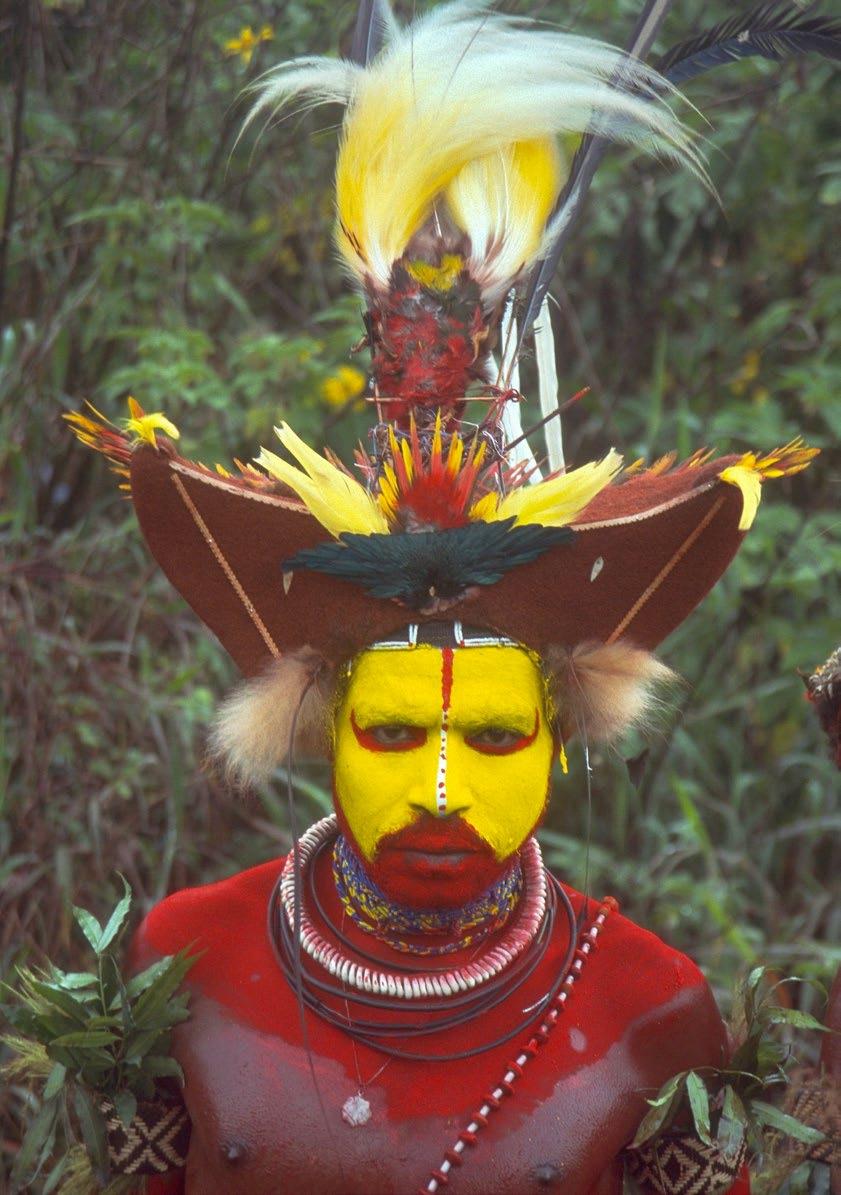

This is an old, well used basket hook, that has been used in a Middle Sepik household over many generations. It is worn and highly patinated on the hook area from constant use. The two faces, morphed bird/ human forms suggest an origin of Chambri Lakes, where this motif is most common. Overall, it is a most elegant basket hook, still retaining some of its original paintwork. Ex-private collection, Perth, Western Australia.


 10. Old Basket Hook, samban, Middle Sepik River, PNG. Wood, pigment.
50 x 21 x 5 cm $2,800
Baskets of food hanging from basket hooks, Middle Sepik River. Early 20th C
10. Old Basket Hook, samban, Middle Sepik River, PNG. Wood, pigment.
50 x 21 x 5 cm $2,800
Baskets of food hanging from basket hooks, Middle Sepik River. Early 20th C

This is obviously a very old object, from the Pitt-Rivers collection and quite small. It is a miniature gable figure; either made as a mannequin for the larger real gable figure, or, perhaps it adorned a Spirit House model. A tag attached to the figure reads ‘‘LONDON SOTHEBY 3/27/85 ‘RUTTER’ LOT #102, EX.STELLA PITT-RIVERS, DORSET M’’. This figure displays all the abstracted forms of a Sawos gable figure, as opposed to the more elegant Iatmul gable figure with curves, flowing lines and fine detail. It produces a stronger, more powerful form.


$2,400
 11. Gable Figure, Sawos region, Middle Sepik River, PNG. Wood.
33 x 20 x 14 cm
Gable figure on the Haus Tambaran, Middle Sepik River, PNG.
11. Gable Figure, Sawos region, Middle Sepik River, PNG. Wood.
33 x 20 x 14 cm
Gable figure on the Haus Tambaran, Middle Sepik River, PNG.

12. Five Yam Masks, Abelam people, East Sepik Province, PNG. Cane, pigment, feathers.
Yam masks were carefully woven from fine cane, tightly bound, by old men, and painted in bright colours. These are used to decorate the large yams after harvest; large yams that acknowledge the special intercession of spirits. This Yam Lining Ceremony is to ensure fertility in the next season of yam growing.
a) Large yam mask, with bulbous bird-like face. Painted with soft red and white ochres.
b) Medium sized yam mask, thick and smoke-imbued. Surrounded by a large cassowary feather headdress. Pink and green pigments.

c) Fine, medium-sized yam mask, with top flange. Finely woven. Pink, blue and white pigments.
d) Miniature yam mask, red and yellow pigments.
e) Miniature yam mask, red and white pigments.
a) 44 x 30 x 14 cm
b) 45 x 70 x 16 cm
c) 25 x 15 x 11 cm
d) 8 x 5 x 3.5 cm
e) 8 x 4.5 x 4 cm
a) $1,200
b) $1,200
c) $800
d) $350
e) $350


This is an old shield, seemingly used in battle, and beautifully painted in triangular motifs. It was almost certainly made post-contact, meaning approx 1950s, when warfare went on, but much repressed by the Australian colonial administration. It seems also that it was probably used later, in 1980s when warfare started to re-emerge after Independence (1975); and this before the introduction of guns into tribal warfare that began to occur in the 1990s. The main motif is a large “X”, that implies an anthropomorphic form, an ancestor form, with arms up and legs apart. Across the middle and top and bottom edges are embellished with triangles, painted alternatly in red, green and white. The design has a wonderful asymmetry. The top edge has a very fine woven cane edge that symbolises a warrior’s headband. In warfare, feathers (generally cassowary spikes) are added that are the shield’s “headdress” that also increase the boldness of the shield in battle

 13. Fighting Shield, Wahgi Valley, Western Highlands, PNG. Wood, fibre, paint.
13. Fighting Shield, Wahgi Valley, Western Highlands, PNG. Wood, fibre, paint.
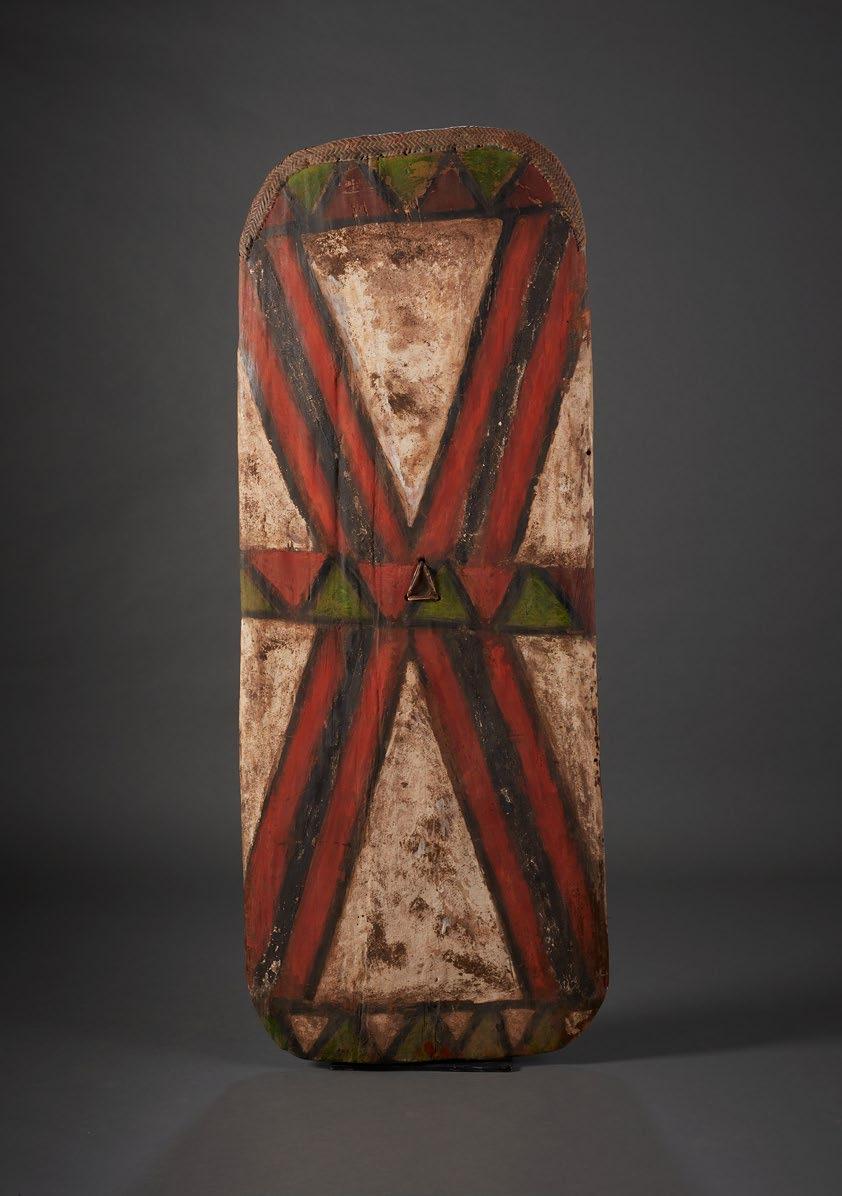

All of these combs are worn on ceremonial ocassions, rather than for daily use. Those for daily use tend to be simple and quite plain.
a) Abelam. With strong face, bird surmounting, shell eyes and pigments.
b) Papuan Gulf. Finely engraved spirit face, highlighted with lime powder.
c) Vanuatu. Simple black palm teeth, woven with cane; surmounted by eagle feathers.
d) Solomon Islands. Malaita, finely made teeth, with cut pearlshell motifs inlaid into tree resin.
e) Abelam. Large spirit face, with shell eyes, surmounted by a flying fox.
a) 29 x 6 cm
b) 27 x 8 cm
c) 49 x 7 cm
d) 23 x 10 cm
e) 30 x 15 cm
a) $350
b) $600
c) $400
d) $500
e) $400


15. Small Old Ancestor Figure, Mundugumor, Yuat River, Lower Sepik River, PNG.
Wood, pearlshell, fibre.
This small figure is from an established Australian collector, who acquired the piece in the early 1970s from a local antique shop. Its previous history is unknown. It has a beautiful old dark brown patina. It has the typical bent legs, hands firmly on the thighs that together energise the figure. Also typical of Mundugumor art are the pearlshell eyes. The figure is small and would have acted as a protective ancestor figure; the pearlshell eyes suggest it was more important, perhaps used in rituals in the Spirit House.


$3,000
 24 x 8 x cm
24 x 8 x cm



clay, pigment.
Ritual life among the two main groups of the Washkuk Hills, the Kwoma and Nukuma, are centred around the cyclical yam fertility ceremonies. Impressive wooden sculptures are made, and also accompanying these are pottery figures. Of the two groups, the Nukuma have bolder pottery figures, with bolder colorations mainly in red and white. This figure, with a large phallic nose is typical. However it has added interest, in that around the base are numerous holes. These suggest that this figure was mounted in some way, possibly tied onto a pole, so that it hovered above the conical display of piled yams, that are always a central part of these ceremonies. This pot is from the second harvest ceremony, called Mindja. Other wooden figures accompany this ceremony, with similar large phallic noses and painted in slabs of red pigments, with details picked out in white. This is an early piece, collected in the early 1970s.

17. Two Aboriginal Phallocrypts, Lonka Lonka, Kimberley Ranges region, Western Australia.
Pearlshell, human hair, pigment.
Originating on the Kimberley coast of WA, these pearlshell objects were traded over wide areas of the Australian continent and were especially revered among the dry desert-dwelling tribes. Ceremonially, they were used as phallocrypts in male initiation ceremonies, using human hair strands as a belt. They could also be used as necklaces or simply objects of magic. The best were engraved with abstract designs signifying water and lightening. Both of these shells were collected by an Aboriginal education officer at Yuendumu, on the edge of the Tanami desert, north-west of Alice Springs in the Northern Territory. Ex-private collection, Sydney.

a) Pearlshell, engraved with a central oval (Rainbow serpent’s egg?) and water designs. Human hair belt.
b) Pearlshell covered in lines and zig-zag dot forms; signify elements of water or rain.
a) 15.5 x 10 cm
b) 13 x 9.5 cm
a) $1,700
b) $1,600
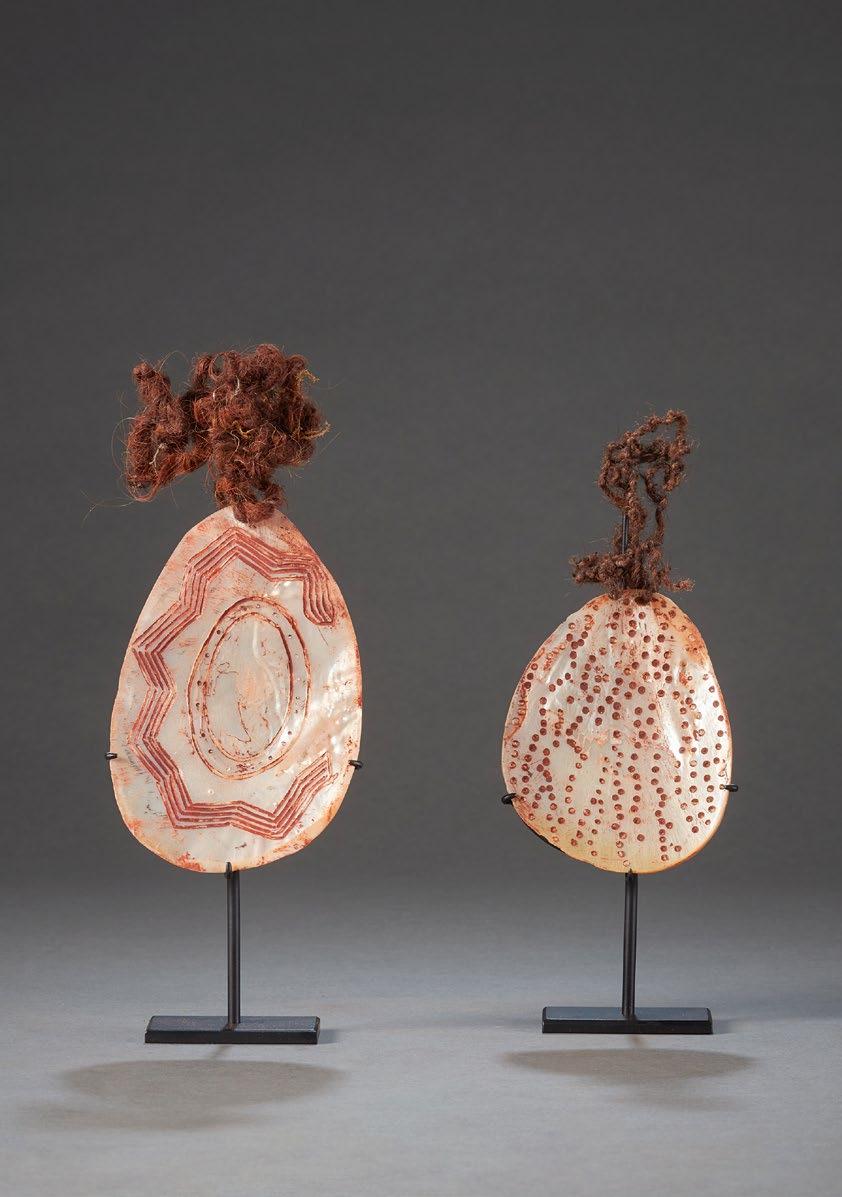
18. Three Aboriginal Churringas, Western Australia. Wood, pigment.

19th / early 20th C.
Churringas, often called message sticks, are finely engraved hardwood forms, usually slender and oval in shape, that carry abstract totemic motifs. Churringas were generally not carried by the largely nomadic Aboriginals, but left in caves or rock shelters alnong their circuitous nomadic route. These are both sacred and ceremonial, carrying designs of tribal history.

a) Churringa, Lagrange Bay, Kimberley Coast, Western Australia. Finely engraved with angular bold design and cross hatching, 19th /
b) Churringa, Central Western Australia. Two brothers collected Aboriginal pieces, and stored on their rural property in 1880-1890s. Later the collection was housed in Black’s Museum, Renmark, South Australia. Fine square-like engraving,
c) Churringa, Lagrange Bay, Kimberley coast, Western Australia.
a) 44.5 x 5 cm
b) 58 x 7 cm
c) 43 x 4 cm
a) $1,000
b) $1,400
c) $900
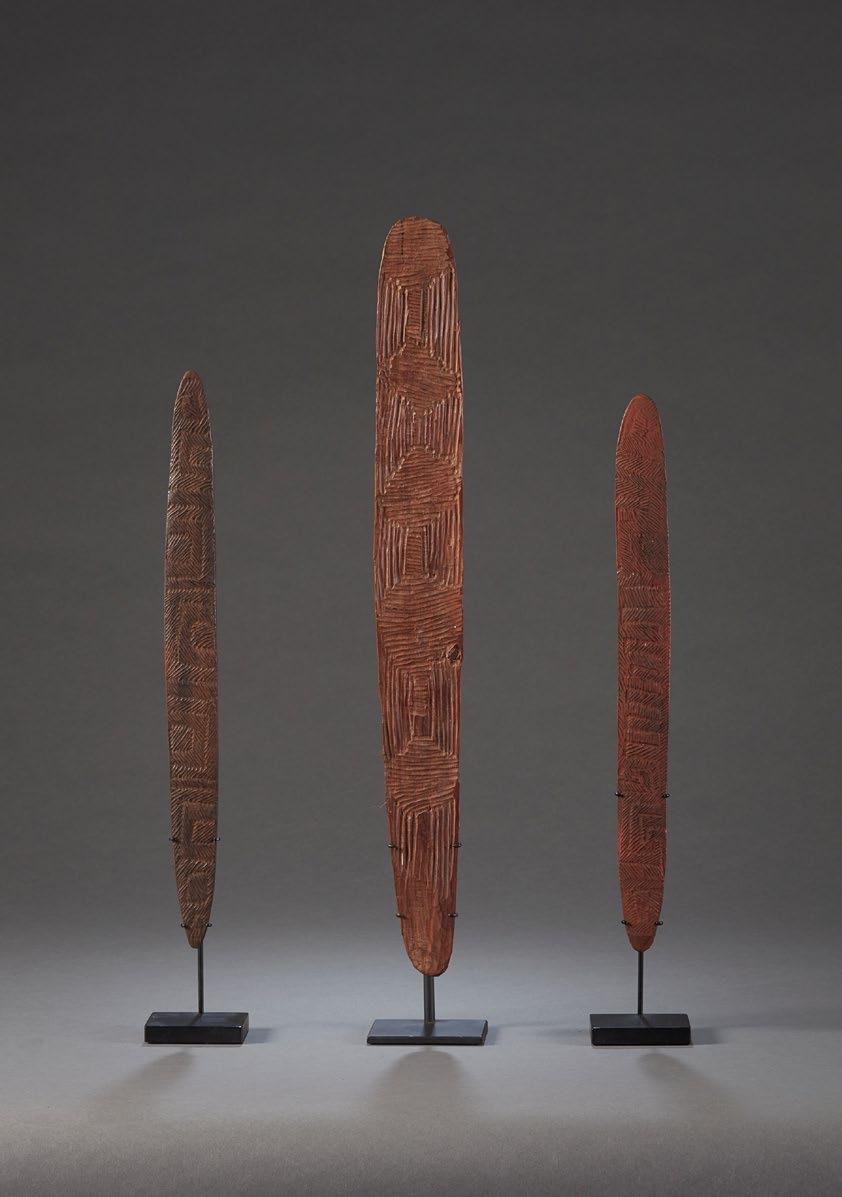
19. Two Fluted Boomerangs, Lake Eyre Region, Central Australia. Wood, pigment.

Boomerangs were used in both hunting and fighting in Central Australia. Both are finely fluted.

Boomerangs can also be used as digging tools to find roots and grubs, as they are a very useful tool in many situations.
a) Boomerang, Lake Eyre region. Ex-McCabe collection, Adelaide, South Australia
b) Boomerang, Lake Eyre region. Ex-McCabe collection, Adelaide, South Australia
a) 66 x 7 cm
b) 78 x 7 cm
a) $650
b) $700
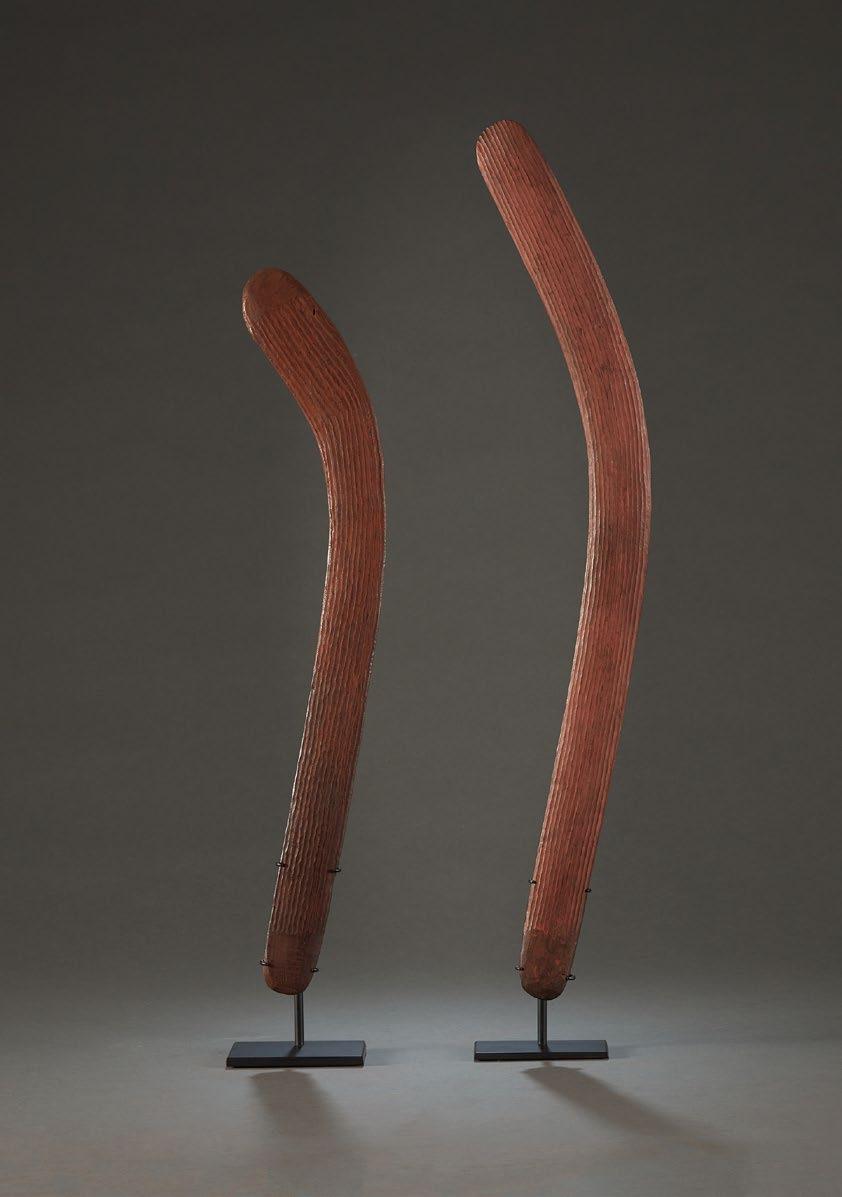
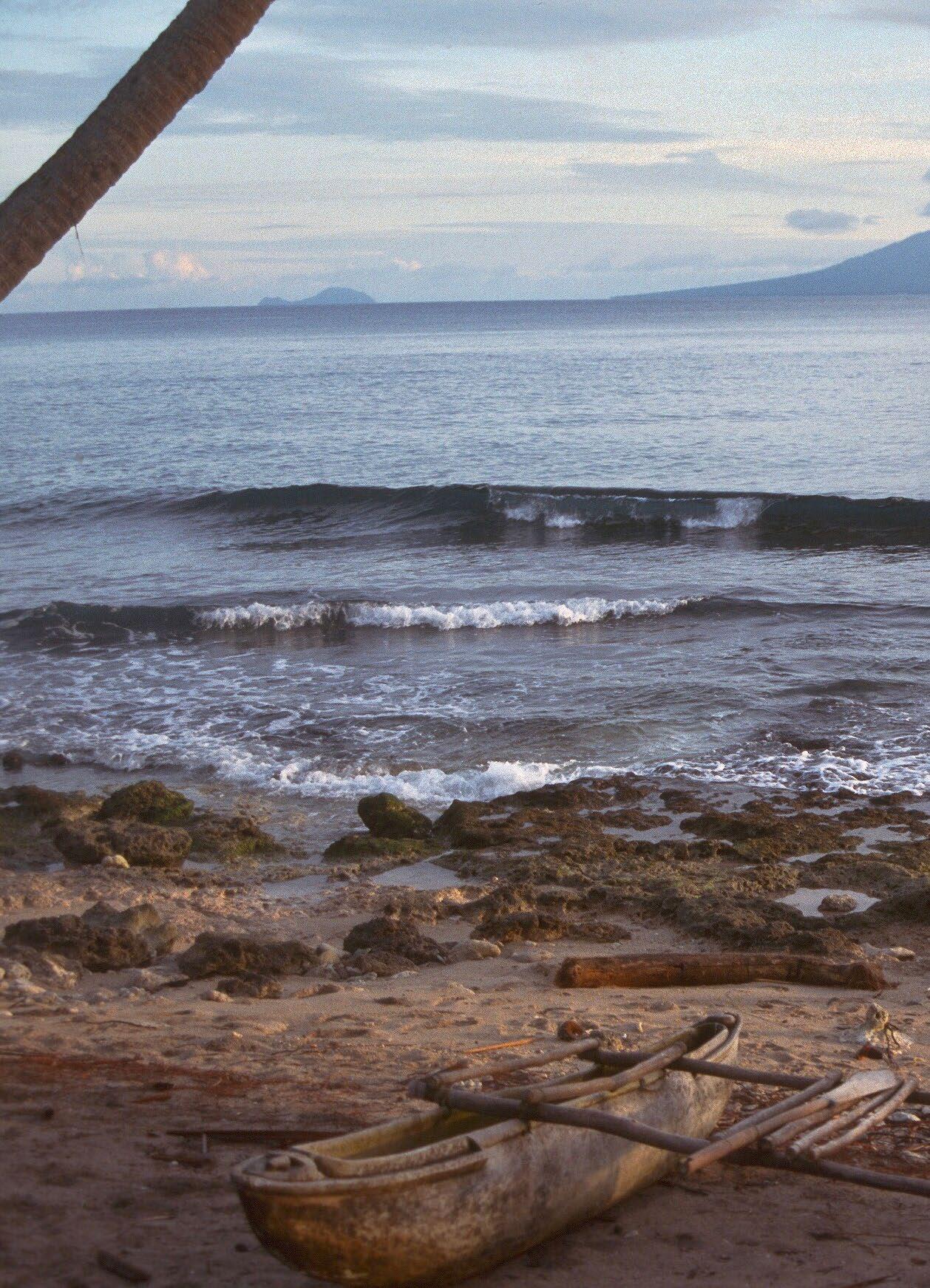
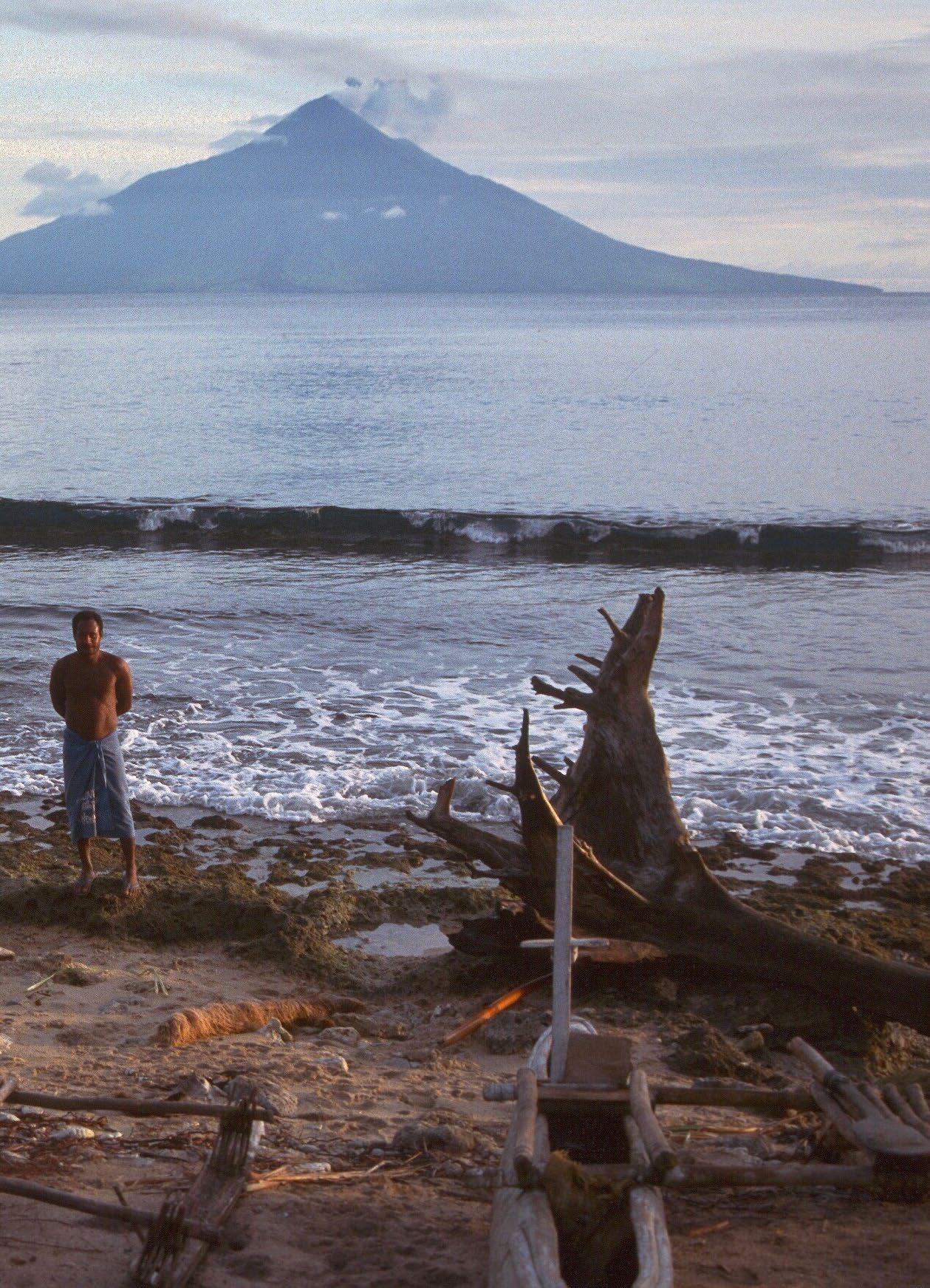
20. Glass Aboriginal Arrow Heads, Kimberley Ranges to Arnhemland, Australia. Glass.

These arrow or spear points made by Aboriginals in 19th Century to early 20th Century used the same pressure flaking technique that they long employed to make stone spear and arrow heads. In fact, Aboriginals recognised that the glass points were even more effective than the stone points, hence their production that to some extent replaced the earlier stone points.

a) Three large spear points made, unusually from window glass rather than bottles.
b) Five smaller arrow points, made from pressure flaked glass bottle glass.
a) i 18 x 6.5
a) ii 18 x 5
a) iii 17 x 6
b) i 7 x 3.5 green
b) ii 5 x 2.5 blue
b) iii 9 x 3.5 grey
b) iv 5 x 2.5 amber
b) v 5 x 2.5 blue
a) i $ 200
a) ii $ 200
a) iii $ 200
b) i $ 300
b) ii $ 350
b) iii $ 350
b) iv $ 300
b) v $ 350


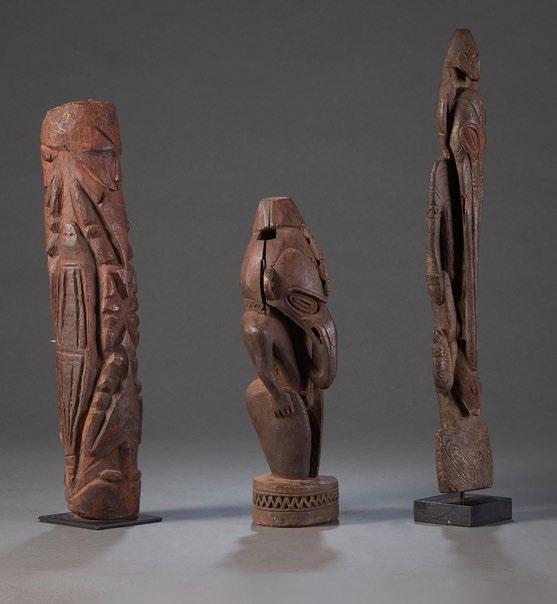
a) Small totem figure, Mundugumor, Yuat River. This figure is carved all-round, post-like, and has some subtle colours in pink and blue. The two faces, quite abstracted, are very well carved, as is the whole figure. Like all ancestor figures, it is most probably a protective piece from the Spirit House, or even a domestic house.
b) Small, strong figure, Murik Lakes, at mouth of Sepik River. The hole at top suggests this figure was hung, rather than standing upright. It would be early 20th Century, and seems to have a decent patina of use.
c) Small, finely engraved figure with two birds. The headdress suggests Coastal Sepik – perhaps Watam Lagoon area, or even possibly the Schroeten Islands. Early 20th Century
a) 47 x 9 x 9 cm
b) 52 x 10 x 5 cm
c) 37 x 13 x 12 cm
a) $2,000
b) $2,400
c) $1,400
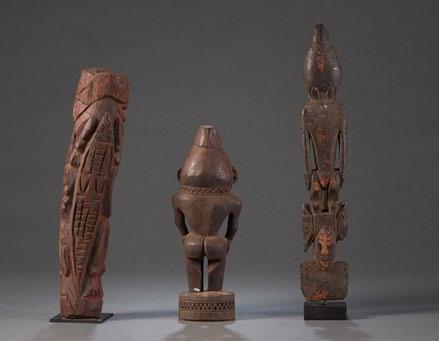
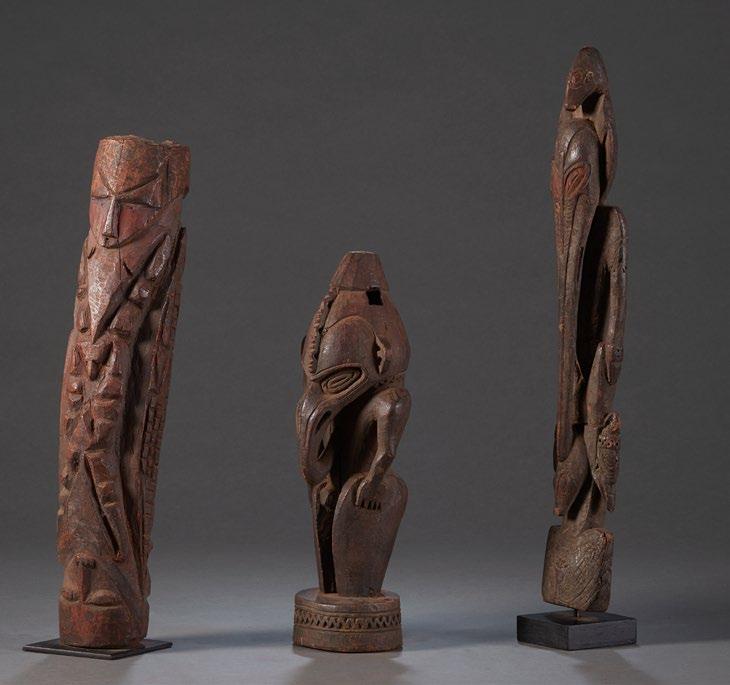
22. Old Dance Mask, Waia village, Manam Island, North Coast, PNG. Wood, conus shell, paint.
19th / early 20th Century.
This is a strong, classic Dance Mask carved in harwood mask from the Sepik/Ramu cultural region. Manam Island, where this mask comes from, is at the far eastern edge of this cultural region. The mask has strong features and conus shell eyes. The edges and holes show much wear and tear, having been used in many ceremonies over its village life. Masks were worn in village secret society ceremonies, generally attached to a much larger dance costume that covers the body of the dancer. These masks are invariably painted red, and there are many layers apparent. The red colour is said to make the mask “hot” and is magical in its own right. The mask is freshly painted before each ceremony when the spiritual intercession is required.



23. Phantom Shield, Kumba Reipi, Wahgi Valley, Western Highlands, PNG. Wood, cane, paint.

“Phantom” is emblazoned in strong yellow at the top of the shield. The Phantom figure itself is running forward, guns drawn. The image has a dynamic feel, showing the strength and determination of a warrior to win; it projects a feeling of invincibility. This is how the Phantom was viewed by wahgi warriors, as the ‘Man Who Cannot Die”. The shield was probably made in the early to mid-1990s, in the period when traditional weapons were still used, but guns were begining to enter tribal warfare. The top edge of the shield has fine criss-cross lines that depict the woven edge band generally found on Wahgi shields. Comics featuring the Phantom became available in the New Guinea Highlands from the late 1970s onwards, and also featured as comic strips in the one national newspaper, The Post Courier. The Phantom character equated with many of the world views of wahgi culture. It became iconic to the extant that the first generation of wahgi Warriors who were literate began to paint the Phantom and other (“new” motifs) on war shields.
 156 x 64 cm $5,000
156 x 64 cm $5,000
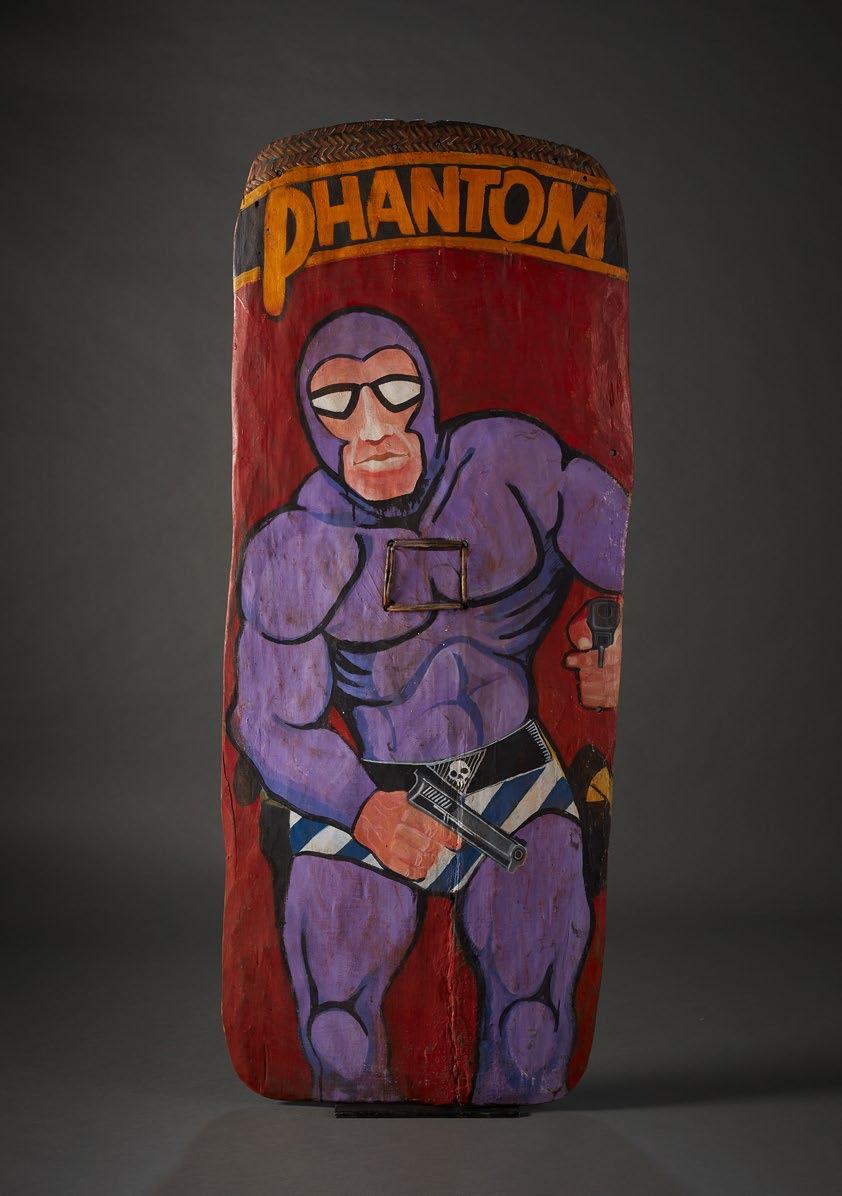
24. Crucifix Figure, Yamok Village, Wawos, Middle Sepik River, PNG. Wood.
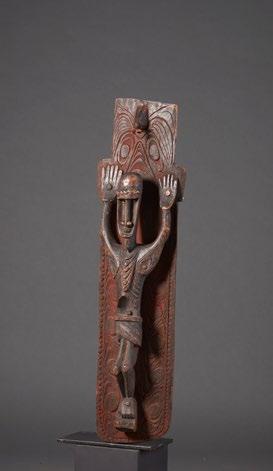
Religious carvings by Sepik carvers date back to the 1950s and 1960s, and this crucifix is one of the earlier examples. Yamok is a large village, an hour’s walk north of the Sepik River, with a well-established Catholic Mission. It was people in this village more than others that produced religious carvings. This crucifix is by a master carver; it retains elements of Yamok carving but transcends it to incorporate this newly accepted religion, and Jesus on the cross as its centre. Sepik motifs featuring circles and chevrons, all to do with natural elements of wind and water, adorn the cross. Old patina.
 95.7 x 27 x 13 cm
$2,800
95.7 x 27 x 13 cm
$2,800

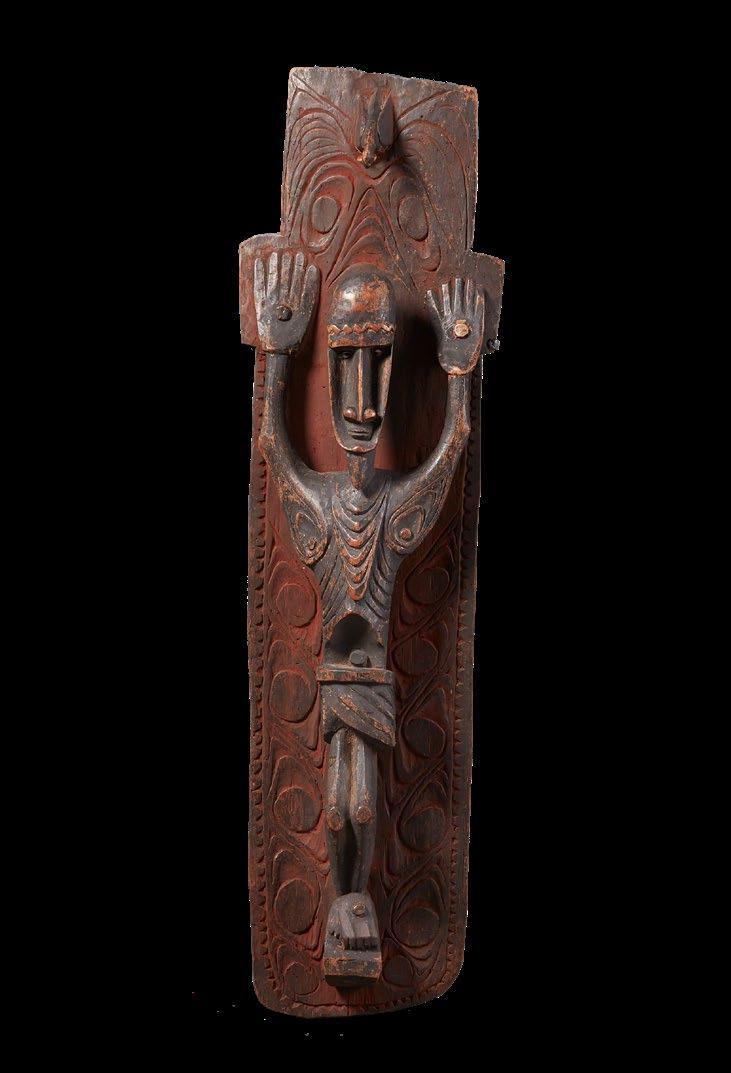
25. Fighting Shield, Warrumbi, Nipa Valley, Southern Highlands, PNG. Wood, fibre, pigment.

Shields of the Nipa Valley are oval in form, similar to many of the shields across these eastern valleys of the Southern Highlands, who share a common language, and are known as warrumbi. Each valley has its distinct designs and motifs. In the Nipa Valley often a central band and bold triangles may be used; and also on this shield a large central circle, bold and abstract. But on further questioning two possible underlying meanings emerge. One is the “Sun”, who is considered one of the primal creator beings. The other is a “navel” which explains a fundamental anthropomorphic meaning that the shield may also be seen to be a man, or more accurately, an ancestor. This rings true, as in the Mendi Valley human-like figures are painted or engraved into their shields.
 144 x 39 cm $4,000
Wola shield makers, Southern Highlands.
Photo: Paul Sillitoe
144 x 39 cm $4,000
Wola shield makers, Southern Highlands.
Photo: Paul Sillitoe
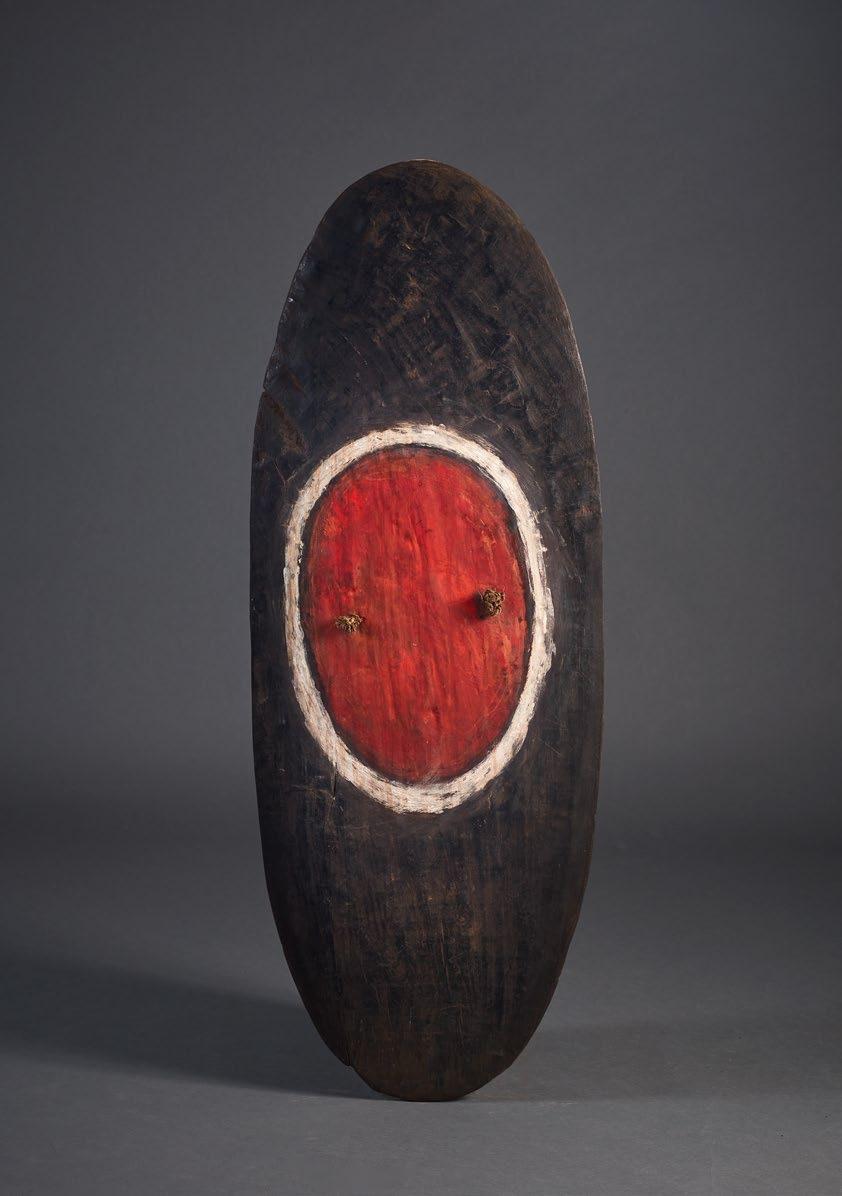
26. Five Yam Masks, Wosera, Southern Abelam, Sepik River Region, PNG. Cane, pigment.

Yam masks were carefully woven from fine cane, tightly bound by old men, and painted in bright colours. These are used to decorate the large yams after harvest; large yams that acknowledge the special intercession of spirits. This Yam Lining Ceremony is to ensure fertility in the next season of yam growing.

a) Large yam mask, with bulbous bird-like face. Very fine weaving, and subtle colourations in muted red, white and black.
b) Large yam mask, with a strong projecting nose (or beak) and a large headdress. Orange, black and white colours
c) Fine, medium-sized yam mask, with intricate headdress form. Very finely woven. Pink, blue and white pigments.
d) Medium-sized yam mask, strong red and yellow colours, with piercing white eyes.
e) Miniature yam mask, green, orange and white pigments.
a) 34 x 20 x 11 cm
b) 45 x 27 x 21 cm
c) 17 x 17 x 6 cm
d) 23 x 13 x 10 cm
e) 10 x 10 x 4 cm
a) $1,000
b) $1,200
c) $900
d) $500
e) $400



Both these board-like figures are from the far western region of the Papuan Gulf, from Goabari Island or the mainland coast immediately adjacent. Both are smaller examples and were carved from the sides of old canoes. The figures represent a powerful ancestor, who lives in the clouds and in mythology guided the people from the west to settle down in their present location. Neither is ancient, coming out of the Gulf in the 1950s or 1960s into private Australian collections.

a) 77 x 19 cm
b) 71 x 21 cm
a) $1,200
b) $950
Goabari Island young man; photo: Frank Hurley, 1923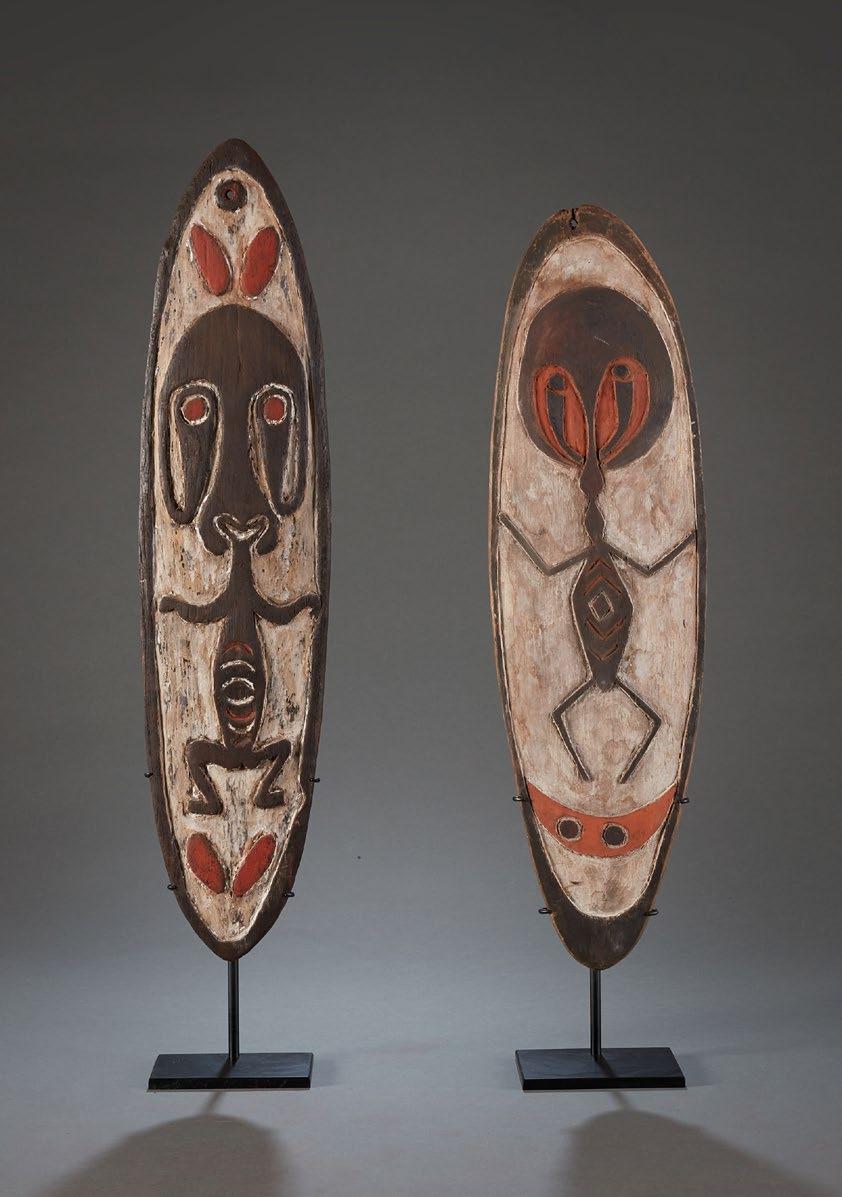
Two Navagation Charts, Rebbello, Marshall Islands, Micronesia. Wood, cowrie shells, paper.
Marshall Islanders built seafearing canoes, travelling vast distances between their low-lying coral atolls, with 34 atolls and more than 1,000 islands spread over thousands of square miles of ocean. They devised charts showing island atolls, and also their knowledge of swell and wave patterns. These are made of sticks, with shells attached to indicate islands. These were teaching devices and the charts were memorised; they were not carried on the canoes. Both ex-private collection, Hawaii.
a) 53 x 28 cm

b) 56 x 49 cm
a) $1,400
b) $1,800

 Polynesian ocean sailing canoe ( model); Auckland Museum
Polynesian ocean sailing canoe ( model); Auckland Museum
29. Eye Mask, Sassoya, Prince Alexander Range, East Sepik, PNG. Cane, cassowary feathers, pigment.


The mask is said to represent an owl, a benevolent ancestral spirit. They are made of two circular cane woven parts, joined, and surrounded by cassowary feathers. The masks are worn by men in ceremonial dance. These are annual ceremonies, generally of large gatherings of many villages, and essentially celebrate fertility in both gardens and hunting. These eye masks are rather rare, found among a relatively small group of villages in the Sassoya region.
$1,400
27 x 27 x 14 cm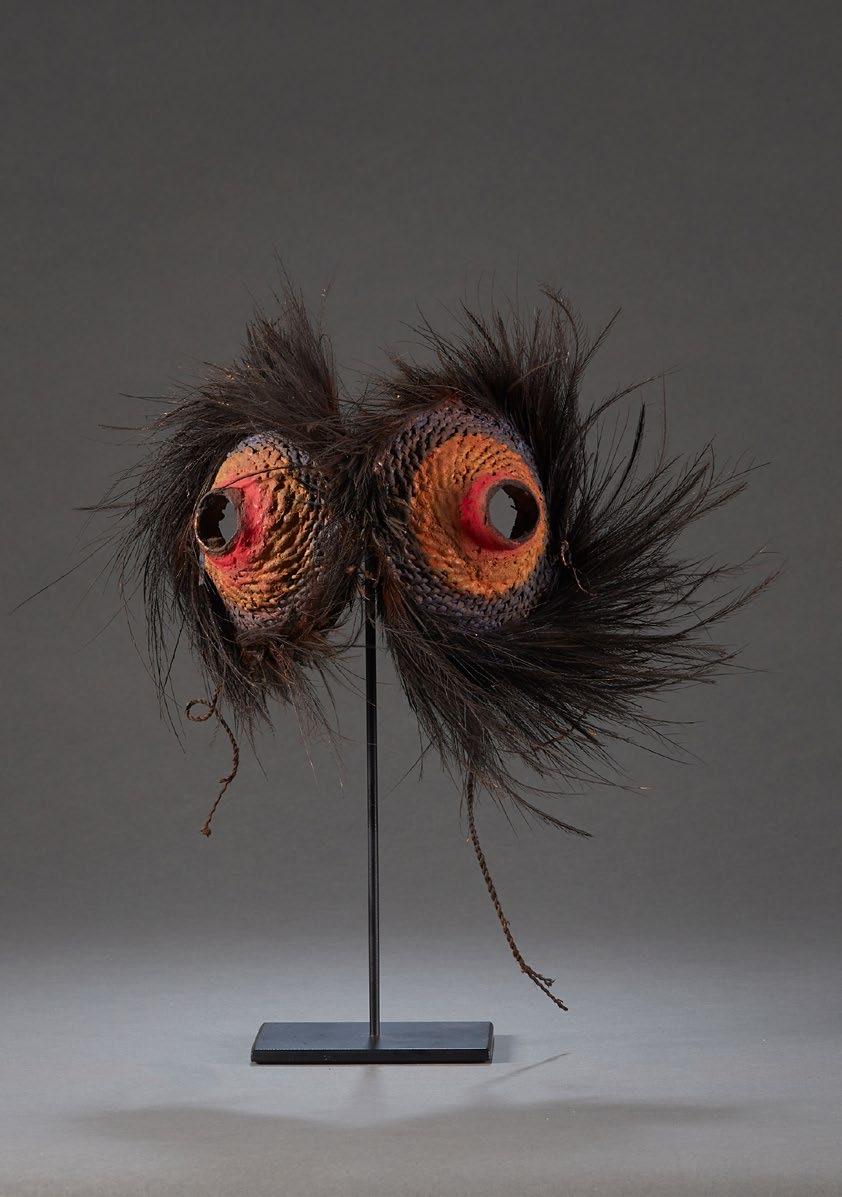
These ancient bowls are objects of magic and ritual. They are used in male cults in the Wahgi Valley region, and fertility rites in the Southern Highlands. They are quite possibly thousands of years old, and not just hundreds. All three came out of the Nembi Valley and Nembi Plateau regions of the Southern Highlands in the colonial era. They are inevitably found when digging in garden areas or house construction, and belong to a previous culture that, researchers tend to think, used them in food preparation. But they are revered as objects sent by the spitits, and became objects of power and magic.
a) Large round bowl, Nembi Valley, rich red interior, and two coloured round stones, referred to as “the eggs”. b) Large round stone bowl, with a chalice-like base, Nembi Valley, rich red interior, and a single large “egg”.
c) Medium chalice-like stone bowl, Nembi Plateau, rich red interior, with a ring of knobs just above its base. The rim has been slightly damaged over its long history. A stone pestle was collected at the same time, with the bowl.


a) 22 diam x 12 cm
b) 21 diam x 11.5 cm
c) 12 diam x 12 cm pestle, 11 x 4.5 cm
a) $1,800
b) $1,600
c) $1,400
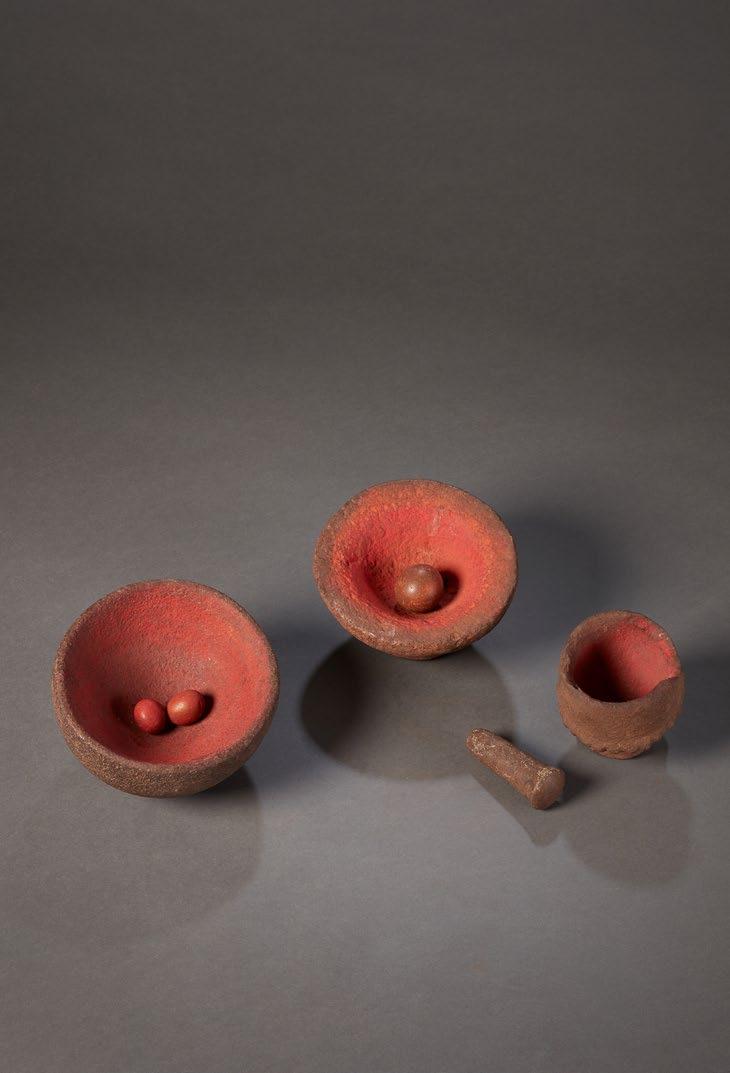
Stone objects were used as the primary cutting and chiselling tool up until contact with the outside world in the 18th and 19th Centuries and, in the New Guinea Highlands, mid-20th Century. They were laboriously fashioned and polished and became much-valued objects.

a) Large adze blade, greenstone, Massim (Trobriand Islands). Used as both tool and wealth object. Ex-Jutta Malnic collection, Sydney.
b) Star club head, Wahgi Valley, Western Highlands. While originally made as a club head, this star shaped stone became incorporated into male cults, and an object of ritual and magic.
c) Aboriginal quartz stone knife, with resin handle.These can be used as regular tool, but an important ceremonial use was in male initiation circumcision. Central Desert area.
d) Fine stone adze blade, greenstone, Mendi Valley, Southern Highlands.
a) 26 x 12 cm
b) 12 diam x 4 cm
c) 19 x 7 cm
d) 16.5 x 6 cm
a) $600
b) $800
c) $400
d) $300


a) Large dark green stone adze, very finely finished and polished, Wahgi Valley, Western Highlands.
b) Large club head with undulating knobs, Wahgi Valley, Western Highlands. The red radiating lines suggest male cult magic was the main purpose of this stone. Ex-old Sydney collection.
c) Medium-sized greenstone blade, Massim (Trobriand Islands) used primarily for wealth and display.
Ex-Jutta Malnic, Sydney.
a) 31 x 7.5 x 3.5 cm
b) 18 diam x 4 cm
c) 19 x 10 x 2 cm
a) $400
b) $700
c) $450
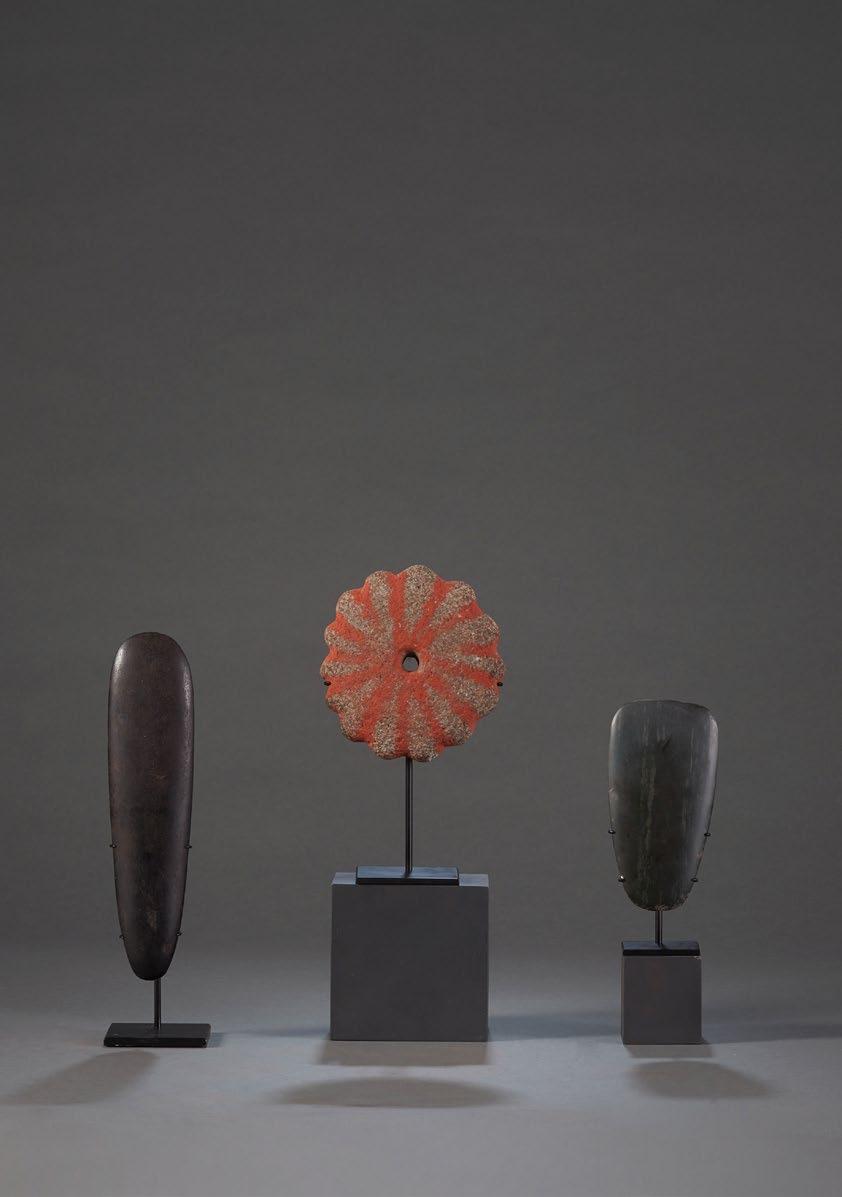
33. Old Fighting Shield, Upper Mendi Valley, Southern Highlands, PNG. Wood, fibre, pigment.
This Mendi shield is not quite the traditional oval-shape; but as most shields were traditionally made by the owners, differences are acceptable. The large abstract figure is engraved into the shield, painted red, and outlined in black. Red is the colour of victory; here the warrior is anticipating both victory and revenge. Sometimes during warfare this figure may be changed to white all over, and this indicates a death among the owner’s allies. Above the figure is a slanted belt of triangles — a typical motif of Mendi Valley shields. The shield shows good age and use, also evidenced on the back. Unusually, the back is painted with a vertical zig-zag line.
 144 x 39 cm $4,000
144 x 39 cm $4,000

34. Long-Nosed Basketry Dance Mask, Tumbuan, Blackwater River, Middle Sepik, PNG.

Cane, pigment.
This style of long-nosed basketry dance mask is found exclusively on the upper reaches of the Blackwater River and Kuvemas Lake. A male dancer wears the mask, with his body totally covered with a grass skirt made of coconut or sago shredded leaves. Most important ceremonies, especially male initiation and the inauguration of a new Haus Tambaran, use these masks in ceremonial dance.
$2,800
 50 x 99 x 29 cm
50 x 99 x 29 cm

a) Papuan Gulf, PNG. This club, referred to as a pineapple club came to Australia in much earlier colonial times. The stone has some small chips from use, but otherwise in very good condition. The handle is old and glossy. Woven cane rings secure the stone to the handle.
b) Anga (or Kukukuku) region, Eastern Highlands, PNG. The Anga people were feared for their volatility, first encountered in the mid-1930s. Until this outside influence, Angas culture was entirely stone-based, with no use of metals. The clubs, especially these robust star-shaped clubs, were heavy and effective in tribal warfare.


a) 89 x 9 diam cm
b) 67 x 27 diam cm
a) $650
b) $900

